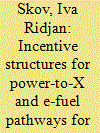| Srl | Item |
| 1 |
ID:
186494


|
|
|
|
|
| Summary/Abstract |
Though Power-to-X pathways, primarily Power-to-Liquids, attract interest as solutions for decarbonising parts of the transport sector that are not suitable for electrification, the regulatory framework until recently slowed down their implementation. This paper examines the updates in the main aspects of the legal framework in the European Union from 2019 to the beginning of 2022 related to Power-to-X: support schemes, specific targets, and potential barriers. The results show increasing interest and market entrance of electrolysis and push from the different actors and regulatory parties to establish solutions that will enable faster upscaling. However, it is visible from the National Energy and Climate Plans and hydrogen strategies that the most emphasis is still on hydrogen as an end fuel for personal vehicles or power-to-gas. On the other hand, few countries have implemented legal frameworks facilitating diverse PtX pathways without focusing solely on hydrogen. Nevertheless, revisions of RED II have finally set up specific targets for electrofuels and Fit for 55 has introduced new actions supporting electrofuels in aviation and marine transport.
|
|
|
|
|
|
|
|
|
|
|
|
|
|
|
|
| 2 |
ID:
191254


|
|
|
|
|
| Summary/Abstract |
The European Commission recently proposed requirements for the production of renewable fuels as these are required to decarbonize the hard-to-electrify parts of the industrial and heavy transport sectors. Power-to-X (P2X) energy hubs enable efficient synergies between energy infrastructures, production facilities, and storage options. In this study, we explore the optimal operation of an energy hub by leveraging the flexibility of P2X, including hydrogen, methanol, and ammonia synthesizers by analyzing potential revenue streams such as the day-ahead and ancillary services markets. We propose EnerHub2X, a mixed-integer linear program that maximizes the hub’s profit based on current market prices, considering the technical constraints of P2X, such as unit commitment and non-linear efficiencies. We investigate a representative Danish energy hub and find that without price incentives, it mainly sells renewable electricity and produces compressed hydrogen. A sufficient amount of renewable ammonia and methanol is only produced by adding a price premium of about 50% (0.16 €/kg) to the conventional fuel prices. To utilize production efficiently, on-site renewable energy sources and P2X must be carefully aligned. We show that renewable power purchase agreements can provide flexibility while complying with the rules set by the European Commission.
|
|
|
|
|
|
|
|
|
|
|
|
|
|
|
|